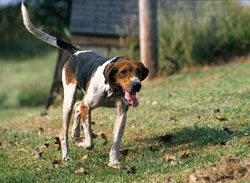Treeing Walker Coonhounds are medium-sized dogs with short, dense, and glossy coats. Ideally, the breed's coat is tri-colored with a combination of white, black, and tan. White or black may be the predominant color. These dogs have large, dark eyes and medium length, hanging ears. Treeing Walker Coonhounds measure 20 to 27 inches tall at the shoulder and weigh 45 to 80 pounds.
These dogs are energetic outdoors and relaxed and gentle when inside the home.
Active, alert, and energetic, Treeing Walker Coonhounds need daily exercise and regular activity to remain physically and mentally healthy. They are sociable and intelligent dogs and make good companion animals for active families with older children. These dogs also make excellent watchdogs and require minimal grooming.
Treeing Walker Coonhounds have a habit of viewing all small creatures as potential prey. For this reason, they should not be left alone with cats, rabbits, or other furry creatures.
Intelligent, hardworking, and friendly, the Treeing Walker Coonhound makes a great companion for active families with children. These dogs are energetic outdoors and relaxed and gentle when inside the home. They get along great with kids, although puppies may be too rambunctious for toddlers. Also, the Treeing Walker Coonhound may be dangerous around rabbits, cats, and other small animals; the creatures are likely to be seen as prey.
These affectionate and playful dogs crave human companionship and may become lonely, depressed, and destructive if ignored or neglected. Ideally, they should have some time outdoors every day, while living and sleeping inside the home with human family members.
Treeing Walker Coonhounds need daily activity to remain healthy and happy. They are not content to lie around watching television all day; these dogs need to be out running and hunting. If hunting is not possible, hiking, long walks, and time in a securely fenced yard to explore and run around are all beneficial.
Treeing Walker Coonhounds are a generally healthy breed, but they are prone to some common coonhound health conditions, including hypothyroidism, hip dysplasia, and various eye problems. Purchasing or adopting one of these dogs from a reputable source that maintains detailed medical and family histories is an important part of ensuring a healthy dog.
The breed is also prone to ear infections, some of which may become serious without prompt veterinary attention. Additionally, the Treeing Walker Coonhound is apt to sustain injuries while hunting in the field. It is important to perform a full body examination upon returning from the field to check for injuries to hidden areas, such as between the toes.
Routine veterinary care, a healthy diet, regular exercise, and standard vaccinations help Treeing Walker Coonhounds live a long and active life of 10 to 13 years.
Although Treeing Walker Coonhounds are more tractable and open to training than other hounds, they are independent dogs and tend to be challenging to work with. For the best results, training should begin very early in life and involve plenty of positive reinforcement, including praise, play, and food rewards. In fact, these dogs will do just about anything for a treat.
Sensitive and eager to please, the breed does not respond well to harsh criticism or punishment. Additionally, training sessions must be kept short and fun to prevent these dogs from tuning out. Training should focus on teaching commands and helping the Treeing Walker Coonhound to understand when it is appropriate to bark and when it isn't. The breed has a deep, loud voice that carries great distances.
To ensure these dogs grow into healthy, well-adjusted, tolerant adults, they should begin socialization from very early in life. As soon as they receive clearance from a veterinarian, the Treeing Walker Coonhound should begin puppy kindergarten classes. Later in life, trips to the dog park and visits to local businesses and neighbors' homes will help keep the breed calm and socialized.
Relatively easy to groom, the Treeing Walker Coonhound requires only occasional brushing with a rubber curry brush to keep the coat healthy and manageable. Regular brushing will keep any loose hair under control, while also distributing skin oils throughout the coat.
Like other scenthounds, Treeing Walker Coonhounds have a musty scent that may be offensive to some people. This odor can be reduced by bathing regularly, but it cannot be removed. Anyone bothered by such an odor should carefully consider this fact before purchasing or adopting one of these dogs.
The nails need trimming every couple of weeks; they should never be allowed to grow so long as to click against the floor when the Treeing Walker Coonhound walks. Additionally, the teeth should be brushed daily with a canine toothpaste and toothpaste, and the ears need weekly checks and cleaning.
Treeing Walker Coonhounds were originally bred for treeing and tracking and evolved from the Walker Foxhound, which in turn developed from the Virginia hounds that descended from some of the first English Foxhounds brought to the United States.
These dogs were originally known as English Coonhounds. In 1945, breeders departed from the English version and started breeding the dogs for the qualities they felt were most important. They renamed the new breed the Treeing Walker.
Today, Treeing Walker Coonhounds are still involved in hunting, outdoor sports, and agility, but they are also popular companion animals in homes with children.
The American Kennel Club did not officially recognize the Treeing Walker Coonhound until 2012.

